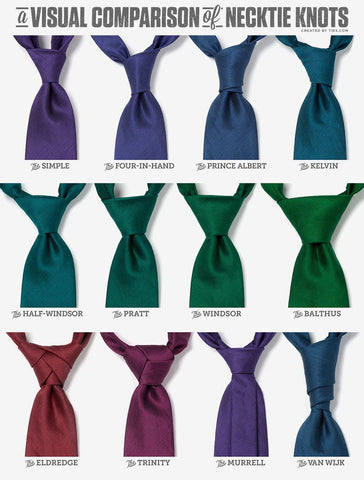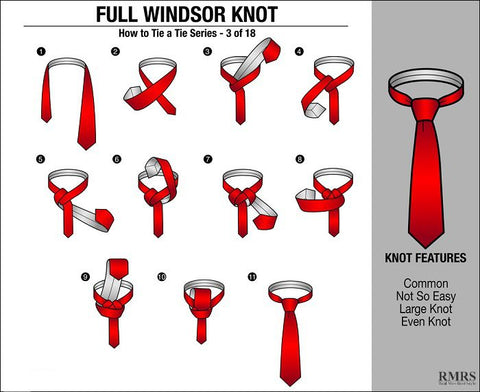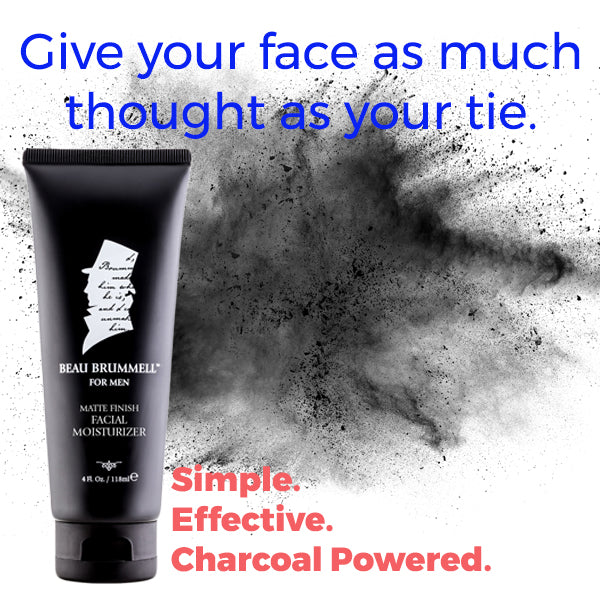Types of tie knots, meanings, and helpful tips

There is no better symbol of gentle-manliness and formal wear than the suit and necktie. Choosing from the many different tie knots is a simple way of expressing taste and class. As you might already know, Beau Brummell popularized the modern day men's suit and necktie in the early 1800's. Since then, we've been donning ties to work, dates, and weddings. There are multiple variations of ties, like the bow tie and the bolo tie, and the necktie itself can be done in many different fashions, depending on the way the knot is tied. Along with the tie, the shoes and cufflinks are an important part of the gentlemen's look.

Not unlike how gifting specific flowers give off a certain message, tie knots too have their own meanings and occasions. Tie knots can look discerningly different, from being uneven, shortened, or being more elaborate. Below, you'll find our picks of tie knots which every guy should be aware of.
To start off, the half-Windsor, Full Windsor, and Four-in-hand knots can be considered the norm since they are easy to tie and versatile. You could say that most of the other types of tie knots are a variation of these three, and the differences are very slight.

THE FULL WINDSOR TIE KNOT
The Windsor knot is also known as Full Windsor, or Double Windsor in order to be further distinguished from its half-Windsor counterpart. It gets its name from the Duke of Windsor, or more precisely, King Edward VIII. The King was told to have preferred wider knots over the popular four-in-hand knot at the time. This also just happens to be the only knot that members of the British Royal Air Force are permitted to use when in uniform.
It sets itself apart with a large, well-balanced, symmetrical knot which can be easily released. Besides that, in relation to other tie knots, it is significantly firmer which means less slippage as time progresses and due to the largeness of its knot, it is quite comfortable as well. This is considered to be the most formal type of tie knots.
THE HALF-WINDSOR TIE KNOT
Considered a medium-sized knot, the half-Windsor is straight and neat, best made with medium to light-weight fabrics. Since the knot is smaller than the Full Windsor, it requires less tie length, and usually tall men prefer it. The half-Windsor finds its place, where formality is concerned, right in between the four-in-hand knot (that is not highly formal, and worn best appropriately at social outings and parties), and the Full Windsor (that is very formal and best suited for events such as weddings and business meetings).
THE FOUR IN HAND TIE KNOT
This is one of the simpler styles of tie knots, also known as the simple knot, or the schoolboy knot. It was at the peak of its popularity in the 19th and the beginning of the 20th century. This knot is the least formal of the 3 so far and is best worn for less formal occasions. Its key features include an asymmetrical small knot and it is best tied from heavy-fabric wide neckties in combination with a standard buttoned-down dress shirt.
How to tie a four in hand knot.
QUICK TIE THOUGHTS
The length of the tie is quite important and should be right on the belt line, not slightly above or below. In today’s world, width popularity goes from skinny to wide and back in the blink of an eye. Vintage, hipster, and many other similar words are thrown around and it simply becomes hard to keep track. Where width is concerned, a good rule of thumb is to go with a tie width roughly similar to the width of your jacket's lapels.
If you do wear a skinny tie, because of the small width, they go best with the four-in-hand knot. If you are a stickler for symmetry then even the half-Windsor is acceptable, however, they look awful with larger knots like the Full Windsor.
COMMON NECKTIE PROBLEMS AND SOLUTIONS
Some people find wearing neckties suffocating or unpleasant, or they even find irritation on their lower neck after some time. These are all things that can be avoided easily enough. Firstly, if you find your tie suffocating, it might mean that you are simply tightening it too much, and if that is not the case, then finding a different type of tie knot which is larger might help better instead.
Don't wear your dress shirts right off the store's rack. You always need to wash them first before wearing since certain chemicals are sometimes used in the manufacturing process. Another cause for irritation can be the shirt fabric itself when in doubt, choose cotton. Lastly, your skin might be irritated from chafing or shaving. Make sure to use a moisturizer daily.
OTHER HONORABLE MENTIONS
You might have heard of the Pratt knot. This knot is a slightly bigger knot than four-in-hand, and lengthens the tie, making it convenient for taller or bigger men. The Pratt knot looks great with a skinny tie.
The trinity knot is more difficult to make and not very suitable for highly formal occasions. It looks unique with its three folded appearance, however, that can be its downfall. Its appearance is too disrupting for some. If you can manage to figure out how to tie this knot, its best worn on casual occasions.
WHAT ABOUT BOW TIES?

The great thing about bow ties is that there is such a large variety nowadays. Gone are the days where bow ties were reserved for black tie affairs. These days, you can don a bow tie and still have a casual, but elevated look. There's just one thing, tying one is really difficult. Like all things, once you get the hang of it, it'll be like riding a bike. Be prepared for a learning curve, and a good deal of time in front of the mirror practicing. Before you opt for that clip on, take a look at this video, and try for yourself!
WANT TO LEARN HOW TO PROPERLY TIE A TIE?
Written down instructions are laughingly impossible to follow, especially for first-timers. The best method to learn how to tie a tie is to watch a video and practice.



Comments (2)
Bart E Macmanus on February 04, 2020
Being a taller man (and having fewer ties designed for taller men) I most often go with the half-windsor out of necessity. However, I much prefer the full Windsor for business.
Chuck Poat on January 14, 2020
Thank you! Brief history, instructions, short and to the point.
Well done.
Back to Blog